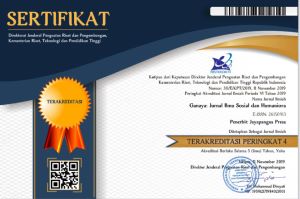Pengaruh User Generated Content Sharing Motives dalam Kolaborasi Lemonilo x NCT DREAM terhadap Sharing Intention Quality
DOI:
https://doi.org/10.37329/ganaya.v6i2.2119Keywords:
Business Communication, User Generated Content, Sharing Intention QualityAbstract
Nowadays, business communication is growing with the presence of user generated content (UGC) as one of the communication strategies through social media. This study aims to examine the influence of UGC Sharing motives on Sharing Intention from a qualitative perspective in the Lemonilo x NCT DREAM collaboration. By 5 motives tested, Self Creation, Community Commitment, Self Expression, Social Relationship and Reward. The method used is a quantitative approach with purposive sampling as the sampling technique. The study population was Lemonilo consumers who knew of the Lemonilo x NCT DREAM collaboration with 100 respondent as a representative sample. By collecting data through surveys using online questionnaires and processig the data through the Partial Least Square (PLS) software application. The results of this study show that Self Creation, Community Commitment, Self Expression, Social Relationship and Reward have a positive effect to UGC Sharing Intention Quality. The positive effect that produced together is 75% according to the Coefficient of Determination (R2) which is 0.757. The results also showed that the Self Creation motive is most dominant in influencing users to share their content compared to other motives. Based on these findings, Lemonilo can communicate its business by increasing content sharing activities in order to direct positive and quality UGC to users.
References
Agung, N. F. A., & Darma, G. S. (2019). Opportunities and Challenges of Instagram Algorithm in Improving Competitive Advantage. International Journal of Innovative Science and Research Technology, 4(1), 743–747.
Arviollisa, P. A. D., Chan, A., & Nirmalasari, H. (2021). The Effect Of Artificial Intelligence (Ai) On Customer Experience (Study Of Gojek User In Bandung, West Java) Putri. 6(2).
Ferinia, R., Kurniullah, A. Z., Naipospos, N. Y., Tjiptadi, D. D., Gandasari, D., Metanfanuan, T., … Watrianthos, R. (2020). Komunikasi Bisnis. Medan: Yayasan Kita Menulis
Fox, A. K., Bacile, T. J., Nakhata, C., & Weible, A. (2017). Selfie-Marketing: Exploring Narcissism and Self-Concept in Visual User-Generated. Journal of Consumer Marketing.
Huo, L., Zhu, J., Singh, P. K., & Pavlovich, P. A. (2021). Research on QR image code recognition system based on artificial intelligence algorithm. Journal of Intelligent Systems, 30(1), 855–867.
Kemp, S. (2022). Digital 2022: Indonesia. Retrieved June 15, 2022, from https://datareportal.com/reports/digital-2022-indonesia
Kusumastuti, Y. I. (2021). Komunikasi Bisnis. Bandung: PT Penerbit IPB Press.
Li, G., Yang, X., & Huang, S. (2014). Effects of social capitaland community support on online communitymembers’ intention to create user-generated content. Journal of Electronic Commerce Research, 15(3).
Mayrhofer, M., Matthes, J., Einwiller, S., & Naderer, B. (2020). User generated content presenting brands on social media increases young adults’ purchase intention. International Journal of Advertising, 39(1), 166–186.
Naab, T. K., & Sehl, A. (2016). Studies of user-generated content: A systematic review. Journalism, 18(10), 1256–1273.
Nisa, C., & Pramesti, D. A. (2019). How Do Effective Digital Marketing and Brand Ambassador Stimulate Purchase Intention Today? 436, 365–367.
Pakpahan, R. (2021). ANALISA PENGARUH IMPLEMENTASI ARTIFICIAL INTELLIGENCE DALAM KEHIDUPAN MANUSIA. Journal of Information System, Informatics and Computing, 5(2), 506–513.
Park, D. H., & Lee, S. (2021). UGC sharing motives and their effects on UGC sharing intention from quantitative and qualitative perspectives: Focusing on content creators in South Korea. Sustainability (Switzerland), 13(17).
Pinuji, M. F., & Satiri. (2019). Pengaruh User-Generated Content Sebagai Alat Komunikasi Bisnis Terhadap Kredibilitas Informasi Website “Tokopedia.” Inter Script: Journal of Creative Communication, 1(1), 19–33.
Ramdhan, M. (2021). Metode Penelitian. Surabaya: Cipta Media Nusantara
Rayinda, M. A., & Irwansyah. (2019). Pengaruh User Generated Content Terhadap Perilaku Para Foodie Pengguna Media Sosial. Jurnal Komunikasi Dan Kajian Media, 3(2), 116–127.
Ruliana, P., Irwansyah, Atmaja, S., Soebiagdo, & Riyanto. (2018). Pemanfaatan Media Sosial Dikalangan Usaha Kecil Dan Menengah (UKM) Keramik Sentra Industri Keramik Plered Kabupaten Purwakarta. Inter komunika: jurnal komunikasi, 3(1), 100–111.
Schaedel, U., & Clement, M. (2015). Managing the online crowd: Motivations for engagement in user-generated content. Journal of Media Business Studies.
Schivinski, B., & Dabrowski, D. (2014). The Effect Of Social Media Communication On Consumer Perceptions Of Brands. Journal of Marketing Communications.
Sudaryono. (2022). Komunikasi Bisnis. Jakarta: Kencana
Umbara, F. W. (2021). User Generated Content di Media Sosial Sebagai Strategi Promosi Bisnis. Jurnal Manajemen Strategi dan Aplikasi Bisnis, 4(2), 572-581.
Downloads
Published
How to Cite
Issue
Section
License
Copyright (c) 2023 Lusianna Lusianna, Sigit Pramono Hadi (Author)

This work is licensed under a Creative Commons Attribution-ShareAlike 4.0 International License.
An author who publishes in the Ganaya : Jurnal Ilmu Sosial dan Humaniora agrees to the following terms:
- Author retains the copyright and grants the journal the right of first publication of the work simultaneously licensed under the Creative Commons Attribution-ShareAlike 4.0 License that allows others to share the work with an acknowledgement of the work's authorship and initial publication in this journal
- Author is able to enter into separate, additional contractual arrangements for the non-exclusive distribution of the journal's published version of the work (e.g., post it to an institutional repository or publish it in a book) with the acknowledgement of its initial publication in this journal.
- Author is permitted and encouraged to post his/her work online (e.g., in institutional repositories or on their website) prior to and during the submission process, as it can lead to productive exchanges, as well as earlier and greater citation of the published work (See The Effect of Open Access).
Read more about the Creative Commons Attribution-ShareAlike 4.0 Licence here: https://creativecommons.org/licenses/by-sa/4.0/.








